The Economics and Statistics Division maintains archives of previous publications for accountability purposes, but makes no updates to keep these documents current with the latest data revisions from Statistics Canada. As a result, information in older documents may not be accurate. Please exercise caution when referring to older documents. For the latest information and historical data, please contact the individual listed to the right.
<--- Return to Archive
For additional information relating to this article, please contact:
May 26, 2020FOOD SERVICES AND DRINKING PLACES, MARCH 2020 During the COVID-19 pandemic, comparisons of year-to-date averages and sums do not show Nova Scotia’s rapidly changing economic situation. The DailyStats will focus on year-over-year comparisons, comparing one month with the same month in the prior year. Where possible the DailyStats will make comparisons of seasonally adjusted data from the pre-COVID-19 period (January and February 2020) with the period during which COVID-19 measures were in place from March 2020 onwards.
"In March, a series of unprecedented government interventions related to COVID-19 were put in place, including the closure of non-essential businesses, travel restrictions, and public health measures directing Canadians to limit public interactions. During the reference period, all provinces restricted access to businesses in the restaurant industry and implemented closures.
Restaurant dining rooms were closed across the country, and take-out and delivery became the only available options. Prior to the pandemic, Quebec was the only province to allow restaurants to sell alcohol with take-out meals. To ease pressures on the industry, most provinces permitted restaurants to sell alcohol for take-out by the end of March, but this did little to maintain sales at their usual levels. Restrictions and closures affecting the food services and drinking places subsector continued into subsequent months." Statistics Canada
Month over month
In March 2020, Statistics Canada on a month-over-month basis, reported that food services and drinking places receipts (seasonally adjusted) in Nova Scotia decreased 32.2 per cent to $98.2 million over February 2020. Food services and drinking places receipts (seasonally adjusted) in Canada decreased 36.6 per cent to $4.0 billion over February 2020.
All provinces reported monthly decreases in food services and drinking places, with Manitoba (-30.4%) reporting the smallest decline, and Quebec (-39.6%) reporting the largest decline in percentage terms.
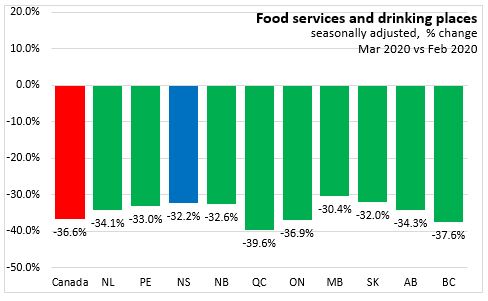
Year-over-Year
In March 2020, on a year-over-year basis, food services and drinking places receipts (seasonally adjusted) in Nova Scotia decreased 30.4 per cent over March 2019. Food services and drinking places receipts (seasonally adjusted) in Canada decreased 35.3 per cent over March 2019.
All provinces reported year-over-year decreases in food services and drinking place receipts, with Prince Edward Island and Nova Scotia (-30.4%) reporting the smallest decline and British Columbia (-37.1%) reporting the largest decline in percentage terms.
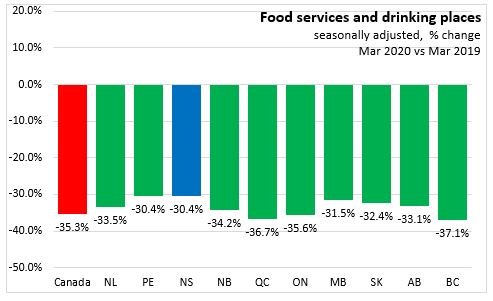
Long-run Trend
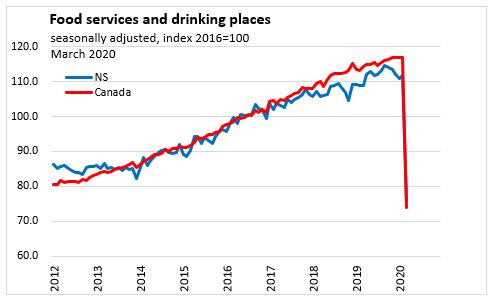
Although Nova Scotia’s food service and drinking place receipts exhibit somewhat more volatile growth from one month to the next, the provincial trend was in line with national growth up to 2017. Throughout 2018 and early 2019 Canada's growth in food services and drinking place receipts has been faster than growth in Nova Scotia. In the spring and summer of 2019, Nova Scotia’s food service and drinking place receipts started to catch up with national growth, peaking in September. Through the fall and winter, Nova Scotia's food services and drinking place receipts have slowed. With COVID-19, the bottom dropped out from both Canada and Nova Scotia markets.
Nova Scotia Year-over-year Sales by Establishment Type
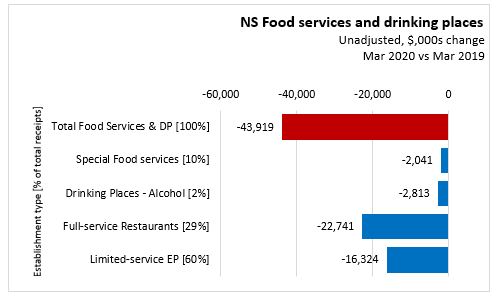
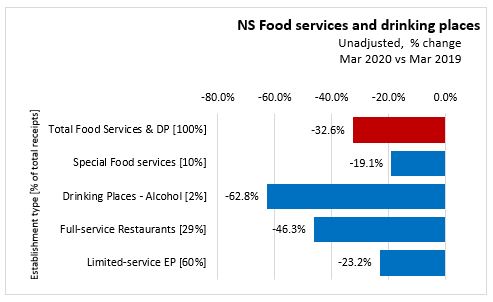
Among types of establishments,
- Limited-service eating places, accounting for 59.6% of total food services and drinking places receipts , decreased 23.2 per cent ($16.3 million) over Mar 2020 vs Mar 2019 to $54 million.
- Full-service restaurants (29.0% of total Food services and drinking places receipts) decreased 46.3 per cent ($22.7 million) to $26 million.
- Special food services (9.5% of total Food services and drinking places receipts) decreased 19.1 per cent ($2.0 million) to $9 million.
- Drinking places -alcoholic beverages (1.8% of total Food services and drinking places receipts) decreased 62.8 per cent ($2.8 million) to $2 million.
BACKGROUND: FOOD SERVICES AND DRINKING PLACES
Each month, Statistics Canada reports on receipts of food services and drinking places for Canada and the Provinces. Food service and drinking place receipts are seasonally adjusted. More detailed data on receipts by type of establishment are available monthly, but these are not seasonally adjusted so only year-over-year or year-to-date analysis is appropriate.
Food service and drinking place establishments include:
- limited-service eating places, where patrons order/select items at a counter and pay before eating either on premises or as take-out
- full-service restaurants, where patrons order and are served while seated and pay after eating
- special food services, such as institutional food contractors, caterers or mobile food providers
- drinking places, primarily engaged in serving alcoholic beverages for immediate consumption (though they sometimes provide limited food services as well)
Source: Statistics Canada. Table 21-10-0019-01 Monthly survey of food services and drinking places (x 1,000)
<--- Return to Archive